 W
WThis is an incomplete list of the paintings by the British Impressionist artist Alfred Sisley, who was born to British parents in France, where he subsequently spent the majority of his life.
 W
WThe Aqueduct at Marly is an 1874 painting by Alfred Sisley. It was bought from the artist by Paul Durand-Ruel in 1876 before being acquired by Edward Libbey, who in turn donated it to the Toledo Museum of Art, where it now hangs. It shows the Aqueduc de Louveciennes. A lifesize reproduction of it is sited at the site of its creation as part of the Pays des Impressionnistes scheme.
 W
WAvenue of Chestnut Trees at La Celle-Saint-Cloud or Edge of the Fontainebleau Forest is an 1865 pre-Impressionist painting by Alfred Sisley, produced in the woods at La Celle-Saint-Cloud. It was refused by the Paris Salon of 1867 and bought by Jean-Baptiste Faure in 1877. It was acquired in 1919 by Joseph Duveen, who in 1921 gave it to the Petit Palais, where it still hangs.
 W
WAvenue of Poplars near Moret-sur-Loing is an 1890 painting by Alfred Sisley.
 W
WThe Banks of the Oise is an 1877-1878 painting by Alfred Sisley. Previously owned by three private galleries it was sold to Chester Dale on 9 June 1926. It is now owned by the National Gallery of Art in Washington, DC, which acquired it with the rest of Dale's collection - it is now on display in section 88.
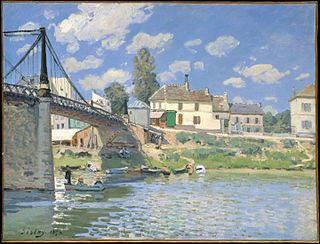 W
WThe Bridge at Villeneuve-la-Garenne is an 1872 painting by Alfred Sisley, now in the Metropolitan Museum of Art.
 W
WThe Canal du Loing in Winter is a painting of the Canal du Loing, produced by Alfred Sisley in winter 1891. It is now in the National Museum of Fine Arts of Algiers.
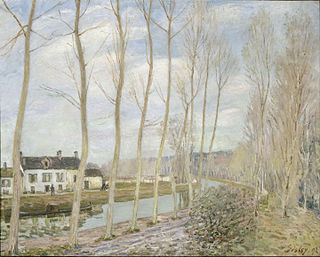 W
WThe Canal du Loing or The Canal du Loing at Moret is an 1892 painting by Alfred Sisley, donated to the Musée du Luxembourg after the painter's death in 1899 by a group of the painter's friends headed by Claude Monet. It is now in the Musée d'Orsay. A similar work, painted in winter 1891, is now in the National Museum of Fine Arts of Algiers.
 W
WThe Canal Saint-Martin is an 1872 painting by Alfred Sisley, now in the Musée d'Orsay, to which it was given in 1907 by Étienne Moreau-Nélaton. The artist was living near the Canal Saint-Martin and the painting formed part of a series of four works showing the canal - another was View of the Canal Saint-Martin.
 W
WChemin de la Machine, Louveciennes or 'Route de Sèvres near Louveciennes is an 1873 painting by Alfred Sisley. Exhibited at the Exposition Universelle of 1900, it entered the Louvre in 1918 from the collection of Joanny Peytel and has been in the Musée d'Orsay since 1986.
 W
WThe Church at Noisy-le-Roi, Autumn Effect or The Bell-Tower at Noisy-le-Roi, Autumn Effect is an Impressionist painting by Alfred Sisley.
 W
WFerry to the Ile-de-la-Loge – Flood is a December 1872 painting by Alfred Sisley. He produced it during a flood on the Seine, which had begun in late October and reached its peak on 17 December.
 W
WFlooding at Port-Marly is the title of two series of paintings by Alfred Sisley, produced at Port-Marly in 1872 and 1876. Two works from the 1876 series are now in the Musée d'Orsay, with one hanging in the museum itself and the other at the Musée des beaux-arts de Rouen.
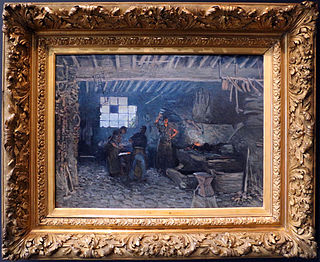 W
WThe Forge at Marly-le-Roi is an 1875 painting by Alfred Sisley. It remained in François Depeaux's collection until its sale in 1906 by the Galerie Georges Petit to Étienne Moreau-Nélaton. Moreau-Nélaton left it to the French state later in 1906 and it has been displayed at the Musée d'Orsay since 1986.
 W
WFrost in Louveciennes is an 1873 painting by Alfred Sisley, which has been in the Pushkin Museum since 1948. It shows the church of St Martin in the French town of Louveciennes. A chalk sketch for it is now in the Budapest Museum of Fine Arts.
 W
WThe Grand-Rue in Argenteuil is an 1872 painting by Alfred Sisley, previously entitled A Street in Sèvres. It is now in Norwich Castle.
 W
WThe Meadow is an 1875 painting by Alfred Sisley, now in section 88 in the National Gallery of Art in Washington DC. It shows a scene near Louveciennes - Pierre-Auguste Renoir painted the same view of Louveciennes that year as Path Through Tall Herbs.
 W
WThe Moret Church series of some dozen oil paintings was executed in 1893/94 by the English Impressionist artist Alfred Sisley. The church building depicted in each of the paintings is the Church of Notre-Dame in the village of Moret-sur-Loing, Seine-et-Marne, France, where Sisley had elected to see out his days until his death in 1899.
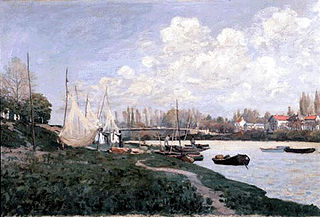 W
WDrying Nets or Fishermen Spreading Their Nets is an 1872 oil on canvas painting by Alfred Sisley, now in the Kimbell Art Museum. The painting shows a scene near the village of Villeneuve-la-Garenne.
 W
WPlace du Chenil in Marly, Snow Effect is an 1876 oil on canvas painting by Alfred Sisley. It is now in the Musée des beaux-arts de Rouen, to which it was given by François Depeaux in 1909 It was painted at Marly-le-Roi and a lifesize reproduction of it is on display near the site of its creation as part of the Pays des Impressionnistes trail.
 W
WRegatta at Molesey near Hampton Court is an 1874 painting by Alfred Sisley, now in the Musée d'Orsay, to which it was allocated in 1986. It was left to the French state by the painter and collector Gustave Caillebotte in 1894 and previously hung in the Musée du Luxembourg (1896-1929), the main building at the Louvre (1929-1947) and the Louvre's galerie du Jeu de Paume (1947-1986).
 W
WResting by a Stream at the Edge of the Wood is an 1878 painting by Alfred Sisley, now in the Musée d'Orsay. It was given to the French state in 1906 as part of Étienne Moreau-Nélaton's collection
 W
WRue de la Chaussée in Argenteuil or A Square in Argenteuil is an 1872 painting by Alfred Sisley, now in the Musée d'Orsay, where it has hung since 1986. It was left to the French state in 1906 by Étienne Moreau-Nélaton, who had bought it earlier that year from François Depeaux's collection via the art dealer Georges Petit.
 W
WThe Seine at Argenteuil is an 1872 painting by Alfred Sisley, now in the Musée Faure in Aix-les-Bains. It was acquired by the doctor and art-lover Jean Faure, who left it to the city.
 W
WThe Seine at Bougival is an 1876 painting by Alfred Sisley, now in the Impressionist section of the Metropolitan Museum of Art, which acquired it in 1992 as a promised and partial gift of Mr and Mrs Douglas Dillon. It shows part of the Seine near Bougival.
 W
WThe Seine at Port-Marly, Piles of Sand is an 1875 painting by Alfred Sisley. It was exhibited at the Exposition Universelle in 1900 whilst in the collection of Dr. Georges Viau, a Paris dentist and art collector. By 4 March 1907 it was owned by Durand-Ruel, who tried and failed to auction it on 4 March that year.
 W
WThe Small Meadows at By, Stormy Weather is a painting by Alfred Sisley, now in the Musée d'art et d'histoire de Meudon. It shows in mirror image the same path as in his The Small Meadows in Spring, By (1881). It was rediscovered in a private home in Kölblöd, Bavaria, Germany in 1949 after being stolen or bought on the black market by Hermann Brandl.
 W
WThe Small Meadows in Spring, By is an 1881 painting by Alfred Sisley, on loan from Tate Britain to the National Gallery since 1997.
 W
WA Street in Marly or Place du Marché is an 1876 oil painting by Alfred Sisley, painted at Port-Marly and now in the Kunsthalle Mannheim. A lifesize reproduction of it is shown near the site of its creation as part of the Pays des Impressionnistes trail.
 W
WThe Terrace at Saint-Germain, Spring is a painting by English Impressionist painter, Alfred Sisley, completed in 1875. It is in The Walters Art Museum collection.
 W
WUnder Hampton Court Bridge is an 1874 painting by Alfred Sisley, now in the Kunstmuseum Winterthur, to which it was given by Dr. Herbert and Charlotte Wolfer de Armas in 1973.
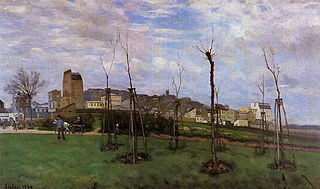 W
WView of Montmartre from Cité des Fleurs to Les Batignolles is a painting by Alfred Sisley, produced in spring 1869 and now in the Musée de Grenoble, France Inv. MG 1317). It was given to that museum in 1901 by the artist's friend and fellow painter Joseph-Auguste Rousselin, only two years after Sisley's death. It is one of the first Impressionist paintings to depict Montmartre, showing it as a still rural area.
 W
WView of the Canal Saint-Martin is an 1870 painting by Alfred Sisley, first exhibited at the Paris Salon of 1870. It was acquired by Gaudoin or Pierre-Firmin. It was then bought by Dr Paul Gachet for 170 francs before 1883. Gachet's son owned it from 1909 onwards and donated it to the Louvre in 1951. It now hangs in the Musée d'Orsay.
 W
WThe Village of Voisins is an 1874 painting by Alfred Sisley, now in the Musée d'Orsay after being left to the French state in 1911 by count Isaac de Camondo. The village shown in the work now forms as district in the town of Louveciennes, where Sisley lived from 1870 to 1874.
 W
WVilleneuve-la-Garenne, Village Beside the Seine or Village on the Seine is an 1872 painting by Alfred Sisley, now in the Hermitage Museum in St Petersburg.
 W
WThe Watering Trough at Marly with Hoarfrost is an 1876 painting by Alfred Sisley. It was owned by François Depeaux, a Sisley collector, and passed through other collections before ending up in that of Paul Mellon. It is now in the Virginia Museum of Fine Arts in Richmond, United States.